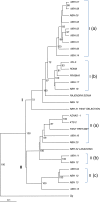Assessment of genetic diversity in indigenous turmeric (Curcuma longa) germplasm from India using molecular markers
- PMID: 25964716
- PMCID: PMC4411392
- DOI: 10.1007/s12298-015-0286-2
Assessment of genetic diversity in indigenous turmeric (Curcuma longa) germplasm from India using molecular markers
Abstract
Curcuma longa L., commonly known as turmeric, is one of the economically and medicinally important plant species. It is predominantly cultivated in the tropical and sub tropical countries. India is the largest producer, and exporter of turmeric in the world, followed by China, Indonesia, Bangladesh and Thailand. In the present study, Directed Amplification of Minisatellite DNA (DAMD) and Inter Simple Sequence Repeats (ISSR), methods were used to estimate the genetic variability in indigenous turmeric germplasm. Cumulative data analysis for DAMD (15) and ISSR (13) markers resulted into 478 fragments, out of which 392 fragments were polymorphic, revealing 82 % polymorphism across the turmeric genotypes. Wide range of pairwise genetic distances (0.03-0.59) across the genotypes revealed that these genotypes are genetically quite diverse. The UPGMA dendrogram generated using cumulative data showed significant relationships amongst the genotypes. All 29 genotypes studied grouped into two clusters irrespective of their geographical affiliations with 100 % bootstrap value except few genotypes, suggesting considerable diversity amongst the genotypes. These results suggested that the current collection of turmeric genotypes preserve the vast majority of natural variations. The results further demonstrate the efficiency and reliability of DAMD and ISSR markers in determining the genetic diversity and relationships among the indigenous turmeric germplasm. DAMD and ISSR profiling have identified diverse turmeric genotypes, which could be further utilized in various genetic improvement programmes including conventional as well as marker assisted breeding towards development of new and desirable turmeric genotypes.
Keywords: DAMD; Genetic diversity; ISSR; Turmeric germplasm.
Figures


Similar articles
-
ISSR and DAMD markers revealed high genetic variability within Flavoparmelia caperata in Western Himalaya (India).Physiol Mol Biol Plants. 2014 Oct;20(4):501-8. doi: 10.1007/s12298-014-0256-0. Epub 2014 Aug 15. Physiol Mol Biol Plants. 2014. PMID: 25320473 Free PMC article.
-
Detecting DNA polymorphism and genetic diversity in Lentil (Lens culinaris Medik.) germplasm: comparison of ISSR and DAMD marker.Physiol Mol Biol Plants. 2014 Oct;20(4):495-500. doi: 10.1007/s12298-014-0253-3. Epub 2014 Aug 8. Physiol Mol Biol Plants. 2014. PMID: 25320472 Free PMC article.
-
Genetic relationships among wild and cultivated accessions of curry leaf plant (Murraya koenigii (L.) Spreng.), as revealed by DNA fingerprinting methods.Mol Biotechnol. 2013 Feb;53(2):139-49. doi: 10.1007/s12033-012-9500-4. Mol Biotechnol. 2013. PMID: 22274940
-
Comparative assessment of ISSR, DAMD and SCoT markers for evaluation of genetic diversity and conservation of landrace chickpea (Cicer arietinum L.) genotypes collected from north-west of Iran.Physiol Mol Biol Plants. 2013 Oct;19(4):563-74. doi: 10.1007/s12298-013-0181-7. Physiol Mol Biol Plants. 2013. PMID: 24431526 Free PMC article.
-
Genetic diversity and relationship of global faba bean (Vicia faba L.) germplasm revealed by ISSR markers.Theor Appl Genet. 2012 Mar;124(5):789-97. doi: 10.1007/s00122-011-1750-1. Epub 2011 Dec 28. Theor Appl Genet. 2012. PMID: 22204023 Review.
Cited by
-
Molecular genetic divergence analysis amongst high curcumin lines of Golden Crop (Curcuma longa L.) using SSR marker and use in trait-specific breeding.Sci Rep. 2023 Nov 11;13(1):19690. doi: 10.1038/s41598-023-46779-5. Sci Rep. 2023. PMID: 37952010 Free PMC article.
-
EST-SSR marker revealed effective over biochemical and morphological scepticism towards identification of specific turmeric (Curcuma longa L.) cultivars.3 Biotech. 2017 May;7(1):84. doi: 10.1007/s13205-017-0701-1. Epub 2017 May 12. 3 Biotech. 2017. PMID: 28500405 Free PMC article.
-
Estimation of genetic diversity and population genetic structure in Gymnema sylvestre (Retz.) R. Br. ex Schult. populations using DAMD and ISSR markers.J Genet Eng Biotechnol. 2023 Apr 6;21(1):42. doi: 10.1186/s43141-023-00497-7. J Genet Eng Biotechnol. 2023. PMID: 37022506 Free PMC article.
-
Study on the genetic variability and adaptability of turmeric (Curcuma longa L.) genotypes for development of desirable cultivars.PLoS One. 2024 Jan 19;19(1):e0297202. doi: 10.1371/journal.pone.0297202. eCollection 2024. PLoS One. 2024. PMID: 38241307 Free PMC article.
-
Mancozeb-induced hepatotoxicity: protective role of curcumin in rat animal model.Toxicol Res (Camb). 2023 Jan 16;12(1):107-116. doi: 10.1093/toxres/tfac085. eCollection 2023 Feb. Toxicol Res (Camb). 2023. PMID: 36866214 Free PMC article.
References
-
- Angle GR, Makeshkumar T, Mohan C, Vimala B, Nambisan B. RAPD genetic diversity analysis of starchy Curcuma species using markers. Plant Biochem Biotechnol. 2008;17:0971–781.
-
- Chandra R, Desai AR, Govind S, Gupta PN. Metroglyph analysis in turmeric (Curcuma longa L.) germplasm in India. Sci Hortic. 1997;70:211–222. doi: 10.1016/S0304-4238(97)00036-8. - DOI
-
- Chandra R, Govind S, Desai AR. Growth, yield and quality performance of turmeric (Curcuma longa L.) genotypes in mid-altitudes of Meghalaya. J Appl Hortic (Lucknow) 1999;1:142–144.
LinkOut - more resources
Full Text Sources
Other Literature Sources
